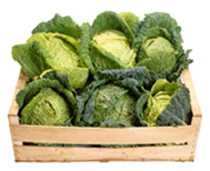How Restaurants Receive Leafy Vegetables
This page shows the study purpose, method, results, conclusions, and recommendations in plain language for the EHS-Net project titled Handling Practices of Fresh Leafy Greens in Restaurants: Receiving and Training.
The findings and recommendations from this project are also in fact sheet format [PDF - 526 KB].
Citations for more EHS-Net publications are available by Study Topic or by Citation.

Study Problem
In recent years, foodborne illness outbreaks have been linked with fresh produce that is eaten without cooking. Such produce includes various leafy vegetables like lettuce, spinach, and cabbage. These vegetables are called leafy greens, and they can be unprocessed, ready to serve, or prepackaged.
We do not know much about how restaurants buy and receive leafy greens. If we learn more about these things, we can suggest ways to improve them, which will lessen the chances of people getting sick.
The U.S. Food and Drug Administration (FDA) advises restaurants on how to stop the spread of germs on leafy greens.
FDA advises
- Not using leafy greens that show rot or damage.
- Refrigerating cut leafy greens at 41°F or less.
- Providing enough records to find out where leafy greens came from. (This is called a traceback investigation.)
Study Purpose
The purpose of this study was to describe how restaurants handle leafy greens in restaurants. Specifically, it focuses on how restaurants buy and receive leafy greens.
Study Findings in Brief
EHS-Net found that many restaurants already use safe ways to handle leafy greens in restaurants.
Study Method
Participants
We collected data in 439 restaurants in the 2008 EHS-Net sites. We picked them at random.
Data Collection
State or local environmental health specialists collected the data. In each restaurant, they
- Talked to a manager,
- Watched food workers handle leafy greens, and
- Took the temperature of leafy greens shipments.
Study Results
Over half of the restaurants buy leafy greens from a company that sells a variety of food products to restaurants, schools, hospitals, and hotels. (This is called a general distributor.) They also buy them from
- Companies that sell large amounts of fresh fruits and vegetables (wholesale produce markets).
- Grocery stores.
- Farmers markets or farms.
Two of three managers said their restaurant had rejected a leafy greens shipment. They rejected shipments because the leafy greens
- Looked bad (wilted, moldy, dirty, or rotten).
- Smelled or tasted bad.
- Were wet or dripping.
- Were not in the right temperature range.
- Were missing a required product label.
Over half of all leafy greens shipments were not delivered at the right temperature (41°F or below). Cut leafy greens shipped and stored above 41°F could support growth of germs that lead to foodborne illness.
Almost all of the managers we talked to said their restaurants keep purchase records of leafy greens. With complete records we can find out where contaminated leafy greens came from.
Top of PageStudy Conclusions
Most restaurants met FDA guidelines for rejecting shipments of leafy greens that looked bad.
Most restaurants met FDA guidelines for keeping purchase records for shipments of leafy greens.
Most restaurants did not meet FDA guidelines for refrigerating cut leafy greens at 41°F or below. Over half of all leafy greens shipments were delivered above 41°F.
EHS-Net Recommends
The restaurant industry may need to develop written guidelines with pictures to explain when shipments of leafy greens should be rejected. This can then be used to make sure restaurants consistently reject bad shipments of leafy greens.
Restaurants are also encouraged to train food workers on FDA’s safe handling advice for leafy greens. This is especially important for restaurants that get shipments of leafy greens that are already cut.
Key Terms
- Environmental health specialists: public health workers who enforce health and safety standards related to food and other consumer products.
- Foodborne illness: an illness caused by germs in food.
- Foodborne illness outbreak: when two or more people have the same sickness after eating food from the same place.
- General distributor: a company that sells a variety of food products to restaurants, schools, hospitals, and hotels.
- Leafy greens: various leafy vegetables like lettuce, spinach and cabbage.
- Traceback investigation: effort to find out where food that caused a foodborne illness outbreak was grown, produced, and packaged.
- Wholesale produce markets: companies that sell large amounts of fresh fruits and vegetables.
- Page last reviewed: August 20, 2013
- Page last updated: August 16, 2016
- Content source:


 ShareCompartir
ShareCompartir